The Good, the Bad, and the Ethical Implications of Bridging Blockchain and Multi-Agent Systems
Abstract
1. Introduction
- (i)
- (ii)
- The study and a development of dynamics enabling the computation of agent reputation through smart contracts;
- (iii)
- A validation of the system in terms of agent behaviors (autonomous and user-dependent) and smart contracts (mechanisms coupled with the agent behaviors and in charge of computing and monitoring the reputation);
- (iv)
- An analysis of the strengths, correctness, drawbacks, challenges, open opportunities, and ethical implications characterizing current and future applications connecting BCT and MAS.
2. State-of-the-Art
2.1. Notions of Multi-Agent Systems
2.2. Notions of Blockchain Technology
2.3. Notions of Trust and Reputation
2.4. Combining MAS and BCT
3. Design of a MAS and BCT Based Architecture
- (i)
- identification and selection of the MAS functionalities to be integrated with or replaced by BCT;
- (ii)
- system design and implementation, including components’ integration and analysis;
- (iii)
- test and evaluation of the system behaviors; and
- (iv)
- critical discussion and evaluation.
- BC-A:
- A regular agent operating in a given community, in which all the interactions are recorded on the blockchain;
- CA-A:
- An agent handling the registration in a given agent community. In particular, the CA-A is in charge of interacting with the certification authority (CA) component of Fabric; the CA-A also offers the possibility of encoding rules and conditions for the enrollment. In the settings of multiple CAs, available in more recent versions of Hyperledger Fabric, similar multi-signature approaches can be employed to manage multiple CA-As.
- Core: the agent instance, in this case implemented in JADE.
- View: the functionality and user interface details.
- Behavior: the set of possible actions.
- Model: the adapter to operate on the underlying BCT.
- Controller: the component connecting the view and model.
- Certification authority (CA): an entity providing valid identities and certificates for the members of the blockchain network.
- Membership service: an entity that identifies CA(s) trusted to define the members of the network. An MScan identify specific roles an actor might play either within the scope of the network and sets the basis for defining access privileges [48].
- Ledger: the immutable, sequenced, tamper resistant register that records all the transactions and the database state.
- Chaincode: a program (also known as a smart contract) that is developed to interact with the ledger.
- Invoke: the APIs called when the invoke transaction is received, in this case from the agents, to process new transaction proposals.
- Assets: a collection of key-value pairs recorded as transactions in the ledger and the respective functions.
4. System Implementation


- avoiding a single point of failure (if the DF is unique in the community),
- reducing the response time when inquired by regular agents,
- improving accessibility and transparency,
- ensuring immutability and traceability.
GUI
5. Interactions and Reputation Management
- an overall reputation value rating the general (average) agent’s reputation;
- a task specific value of a given service and role (demander/executor).
- agreement on a specific value (with a minor variance),
- disagreement (the evaluations of demander and executor have a misalignment greater than a customizable threshold).
6. Discussion
6.1. Strengths of Binding BCT and MAS
6.2. Correctness in Binding BCT and MAS
6.3. Drawbacks of Binding BCT and MAS
6.4. Challenges and Opportunities in Binding BCT and MAS
7. Ethical Implications of Binding MAS and BCT in Real-World Scenarios
8. Conclusions
Author Contributions
Funding
Conflicts of Interest
References
- Calvaresi, D.; Cesarini, D.; Sernani, P.; Marinoni, M.; Dragoni, A.; Sturm, A. Exploring the ambient assisted living domain: A systematic review. J. Ambient Intell. Humaniz. Comput. 2017, 8, 239–257. [Google Scholar] [CrossRef]
- Calvaresi, D.; Marinoni, M.; Dragoni, A.F.; Hilfiker, R.; Schumacher, M. Real-time multi-agent systems for telerehabilitation scenarios. Artif. Intell. Med. 2019, 96, 217–231. [Google Scholar] [CrossRef] [PubMed]
- Hsieh, F.S. Modeling and control of holonic manufacturing systems based on extended contract net protocol. In Proceedings of the 2002 American Control Conference, Anchorage, AK, USA, 8–10 May 2002; Volume 6, pp. 5037–5042. [Google Scholar]
- Rajkumar, R.R.; Lee, I.; Sha, L.; Stankovic, J. Cyber-physical systems: The next computing revolution. In Proceedings of the 47th Design Automation Conference, Anaheim, CA, USA, 13–18 June 2010. [Google Scholar]
- Schatten, M.; Ševa, J.; Tomičić, I. A roadmap for scalable agent organizations in the internet of everything. J. Syst. Softw. 2016, 115, 31–41. [Google Scholar] [CrossRef]
- Shoham, Y. Agent-oriented programming. Artif. Intell. 1993, 60, 51–92. [Google Scholar] [CrossRef]
- Russell, S.J.; Norving, P. Artificial Intelligence: A Modern Approach; Prentice Hall: Subang Jaya, Selangor, Malaysia, 2002; pp. 111–114. [Google Scholar]
- Calvaresi, D.; Marinoni, M.; Sturm, A.; Schumacher, M.; Buttazzo, G. The Challenge of Real-Time Multi-Agent Systems for Enabling IoT and CPS. In Proceedings of the IEEE/WIC/ACM International Conference on Web Intelligence, Leipzig, Germany, 23–26 August 2017. [Google Scholar] [CrossRef]
- Calvaresi, D.; Mattioli, V.; Dubovitskaya, A.; Dragoni, A.F.; Schumacher, M. Reputation Management in Multi-Agent Systems Using Permissioned Blockchain Technology. In Proceedings of the 2018 IEEE/WIC/ACM International Conference onWeb Intelligence (WI), Santiago, Chile, 3–6 December 2018; pp. 719–725. [Google Scholar]
- Calvaresi, D.; Dubovitskaya, A.; Retaggi, D.; Dragoni, A.F.; Schumacher, M. Trusted registration, negotiation, and service evaluation in multi-agent systems throughout the blockchain technology. In Proceedings of the 2018 IEEE/WIC/ACM International Conference onWeb Intelligence (WI), Santiago, Chile, 3–6 December 2018; pp. 56–63. [Google Scholar]
- Yu, B.; Singh, M.P. An evidential model of distributed reputation management. In Proceedings of the First International Joint Conference on Autonomous Agents and Multiagent Systems: Part 1, Bologna, Italy, 15–19 July 2002; pp. 294–301. [Google Scholar]
- Ramchurn, S.D.; Huynh, D.; Jennings, N.R. Trust in multi-agent systems. Knowl. Eng. Rev. 2004, 19, 1–25. [Google Scholar] [CrossRef]
- Hedin, Y.; Moradian, E. Security in Multi-Agent Systems. Procedia Comput. Sci. 2015, 60, 1604–1612. [Google Scholar] [CrossRef]
- Kvaternik, K.; Laszka, A.; Walker, M.; Schmidt, D.; Sturm, M.; Lehofer, M.; Dubey, A. Privacy-Preserving Platform for Transactive Energy Systems. arXiv 2017, arXiv:1709.09597. [Google Scholar]
- Qayumi, K. Multi-agent Based Intelligence Generation from Very Large Datasets. In Proceedings of the 2015 IEEE International Conference on Cloud Engineering (IC2E), Tempe, AZ, USA, 9–13 March 2015; pp. 502–504. [Google Scholar]
- Norta, A.; Othman, A.B.; Taveter, K. Conflict-Resolution Lifecycles for Governed Decentralized Autonomous Organization Collaboration. In Proceedings of the 2015 2nd International Conference on Electronic Governance and Open Society: Challenges in Eurasia, St. Petersburg, Russia, 24–25 November 2015. [Google Scholar]
- Ponomarev, S.; Voronkov, A. Multi-agent systems and decentralized artificial superintelligence. arXiv 2017, arXiv:1702.08529. [Google Scholar]
- Swan, M. Blockchain: Blueprint for a New Economy; O’Reilly Media, Inc.: Sebastopol, CA, USA, 2015. [Google Scholar]
- Tapscott, D.; Tapscott, A. Blockchain Revolution: How the Technology behind Bitcoin Is Changing Money, Business, and the World; Penguin: New York, NY, USA, 2016. [Google Scholar]
- Calvaresi, D.; Dubovitskaya, A.; Calbimonte, J.P.; Taveter, K.; Schumacher, M. Multi-agent systems and blockchain: Results from a systematic literature review. In Proceedings of the International Conference on Practical Applications of Agents and Multi-Agent Systems, Toledo, Spain, 20–22 June 2018; pp. 110–126. [Google Scholar]
- Bellifemine, F.L.; Caire, G.; Greenwood, D. Developing Multi-Agent Systems with JADE; John Wiley & Sons: Chichester, UK, 2007; Volume 7. [Google Scholar]
- Androulaki, E.; Barger, A.; Bortnikov, V.; Cachin, C.; Christidis, K.; De Caro, A.; Enyeart, D.; Ferris, C.; Laventman, G.; Manevich, Y.; et al. Hyperledger fabric: A distributed operating system for permissioned blockchains. In Proceedings of the Thirteenth EuroSys Conference, Porto, Portugal, 23–26 April 2018; p. 30. [Google Scholar]
- Nakamoto, S. Bitcoin: A Peer-to-Peer Electronic Cash System. 2008. Available online: https://bitcoin.org/bitcoin.pdf (accessed on 18 November 2019).
- Pass, R.; Shi, E. Hybrid consensus: Efficient consensus in the permissionless model. In Proceedings of the LIPIcs-Leibniz International Proceedings in Informatics, Budapest, Hungary, 29 May–1 June 2017; Volume 91. [Google Scholar]
- Cachin, C.; Vukolić, M. Blockchains Consensus Protocols in the Wild. arXiv 2017, arXiv:1707.01873. [Google Scholar]
- Buterin, V. Ethereum: A Next-Generation Smart Contract and Decentralized Application Platform. Available online: https://github.com/ethereum/wiki/wiki/%5BEnglish%5D-White-Paper (accessed on 18 November 2019).
- O’Dwyer, K.J.; Malone, D. Bitcoin Mining and Its Energy Footprint; ISSC 2014/CIICT 2014; IET: Limerick, Ireland, 2013; pp. 280–285. [Google Scholar]
- Gervais, A.; Karame, G.O.; Wüst, K.; Glykantzis, V.; Ritzdorf, H.; Capkun, S. On the security and performance of proof of work blockchains. In Proceedings of the 2016 ACM SIGSAC Conference on Computer and Communications Security, Vienna, Austria, 24–28 October 2016; pp. 3–16. [Google Scholar]
- Buldas, A.; Kroonmaa, A.; Laanoja, R. Keyless signatures’ infrastructure: How to build global distributed hash-trees. In Proceedings of the Nordic Conference on Secure IT Systems, Ilulissat, Greenland, 18–21 October 2013; pp. 313–320. [Google Scholar]
- Buldas, A.; Saarepera, M. On Provably Secure Time-Stamping Schemes. In Proceedings of the ASIACRYPT, Jeju Island, Korea, 5–9 December 2004; Volume 3329, pp. 500–514. [Google Scholar]
- Savage, L.J. The Foundations of Statistics; Dover Inc.: New York, NY, USA, 1972. [Google Scholar]
- Dragoni, A.; Mascaretti, F.; Puliti, P. A generalized approach to consistency based belief revision. Lect. Notes Comput. Sci. 1995, 992, 231–236. [Google Scholar]
- Dragoni, A.; Giorgini, P. Distributed Belief Revision. Auton. Agents Multi Agent Syst. 2003, 6, 115–143. [Google Scholar] [CrossRef]
- Dragoni, A.; Animali, S. Maximal consistency, theory of evidence, and bayesian conditioning in the investigative domain. Cybern. Syst. 2003, 34, 419–465. [Google Scholar] [CrossRef]
- Dragoni, A.; Giorgini, P. Learning agents’ reliability through bayesian conditioning: A simulation experiment. Lect. Notes Comput. Sci. 1997, 1221, 151–167. [Google Scholar]
- Norta, A.; Vedeshin, A.; Rand, H.; Tobies, S.; Rull, A.; Poola, M.; Rull, T. Self-Aware Agent-Supported Contract Management on Blockchains for Legal Accountability. 2017. Available online: http://whitepaper.agrello.org/Agrello_Self-Aware_Whitepaper (accessed on 18 November 2019).
- Ferrer, E.C. The blockchain: A new framework for robotic swarm systems. arXiv 2016, arXiv:1608.00695. [Google Scholar]
- Mariani, S.; Omicini, A.; Ciatto, G. Novel Opportunities for Tuple based Coordination: XPath, the Blockchain, & Stream Processing. In 18th Workshop “From Objects to Agents”; Sun SITE Central Europe; RWTH Aachen University: Aachen, Germany, 2017; Volume 1867. [Google Scholar]
- Skowroński, R. The open blockchain-aided multi-agent symbiotic cyber–physical systems. Future Gener. Comput. Syst. 2019, 94, 430–443. [Google Scholar] [CrossRef]
- Gattermayer, J.; Tvrdik, P. Blockchain based multi-level scoring system for P2P clusters. In Proceedings of the 2017 46th International Conference on Parallel Processing Workshops ICPPW, Bristol, UK, 14–17 August 2017; pp. 301–308. [Google Scholar]
- Leiding, B.; Norta, A. Mapping Requirements Specifications into a Formalized Blockchain-Enabled Authentication Protocol for Secured Personal Identity Assurance. In International Conference on Future Data and Security Engineering; Springer: Cham, Switzerland, 2017. [Google Scholar]
- Shen, J.; Shen, J.; Huang, Y.; Huang, Y.; Chai, Y.; Chai, Y. A cyber-anima based model of material conscious information network. Int. J. Crowd Sci. 2017. [Google Scholar] [CrossRef]
- Bonino, D.; Vergori, P. Agent Marketplaces and Deep Learning in Enterprises: The COMPOSITION Project. In Proceedings of the Annual Computer Software and Applications Conference, Turin, Italy, 4–8 July 2017; pp. 749–754. [Google Scholar]
- Kiyomoto, S.; Rahman, M.S.; Basu, A. On blockchain based anonymized dataset distribution platform. In Proceedings of the 2017 IEEE 15th International Conference on Software Engineering Research, Management and Applications (SERA), London, UK, 7–9 June 2017; pp. 85–92. [Google Scholar]
- McConaghy, T.; Marques, R.; Müller, A.; De Jonghe, D.; McConaghy, T.; McMullen, G.; Henderson, R.; Bellemare, S.; Granzotto, A. BigchainDB: A Scalable Blockchain Database; BigChainDB: Berlin, Germany, 2016. [Google Scholar]
- Feng, L.; Zhang, H.; Chen, Y.; Lou, L. Scalable Dynamic Multi-Agent Practical Byzantine Fault-Tolerant Consensus in Permissioned Blockchain. Appl. Sci. 2018, 8, 1919. [Google Scholar] [CrossRef]
- Cachin, C. Architecture of the hyperledger blockchain fabric. Workshop Distrib. Cryptocurr. Consens. Ledgers 2016, 310, 4. [Google Scholar]
- IBM. Hyperledger-Fabric Online Documentation. Available online: https://hyperledger-fabric.readthedocs.io/en/release-1.2/ (accessed on 10 September 2018).
- Tessier, C.; Chaudron, L.; Müller, H.J. Conflicting Agents: Conflict Management in Multi-Agent Systems; Springer Science & Business Media: New York, NY, USA, 2006; Volume 1. [Google Scholar]
- Resmerita, S.; Heymann, M. Conflict resolution in multi-agent systems. In Proceedings of the IEEE Conference on Decision and Control, Maui, HI, USA, 9–12 December 2003; Volume 3, pp. 2537–2542. [Google Scholar]
- Vasconcelos, W.W.; Kollingbaum, M.J.; Norman, T.J. Normative conflict resolution in multi-agent systems. Auton. Agents Multi Agent Syst. 2009, 19, 124–152. [Google Scholar] [CrossRef]
- Hull, R.; Batra, V.S.; Chen, Y.M.; Deutsch, A.; Heath, F.F.T., III; Vianu, V. Towards a shared ledger business collaboration language based on data-aware processes. In Proceedings of the International Conference on Service-Oriented Computing, Banff, AB, Canada, 10–13 October 2016; pp. 18–36. [Google Scholar]
- Shermin, V. Disrupting governance with blockchains and smart contracts. Strateg. Chang. 2017, 26, 499–509. [Google Scholar] [CrossRef]
- Dumas, M.; Hull, R.; Mendling, J.; Weber, I. Blockchain Technology for Collaborative Information Systems (Dagstuhl Seminar 18332). Available online: http://drops.dagstuhl.de/opus/volltexte/2019/10236/ (accessed on 18 November 2019).
- Wüst, K.; Gervais, A. Do You Need a Blockchain? Available online: https://ieeexplore.ieee.org/abstract/document/8525392 (accessed on 18 November 2019).
- Anjomshoae, S.; Najjar, A.; Calvaresi, D.; Främling, K. Explainable agents and robots: Results from a systematic literature review. In Proceedings of the 18th International Conference on Autonomous Agents and MultiAgent Systems, Montreal, QC, Canada, 13–17 May 2019; pp. 1078–1088. [Google Scholar]
- Calvaresi, D.; Mualla, Y.; Najjar, A.; Galland, S.; Schumacher, M. Explainable Multi-Agent Systems through Blockchain Technology; Springer: Montreal, QC, Canada, 2019. [Google Scholar]
- Abramova, O.; Shavanova, T.; Fuhrer, A.; Krasnova, H.; Buxmann, P. Understanding the Sharing Economy: The Role of Response to Negative Reviews in the Peer-to-peer Accommodation Sharing Network. In Proceedings of the European Conference on Information Systems, Münster, Germany, 26–29 May 2015; Volume 2, pp. 175–193. [Google Scholar]
- Origgi, G.; Pais, I. Digital reputation in the mutual admiration society. Studi Di Sociol. 2018, 2, 175–193. [Google Scholar]
- Mayzlin, D.; Dover, Y.; Chevalier, J. Promotional reviews: An empirical investigation of online review manipulation. Am. Econ. Rev. 2014, 104, 2421–2455. [Google Scholar] [CrossRef]
- Luca, M.; Zervas, G. Fake it till you make it: Reputation, competition, and Yelp review fraud. Manag. Sci. 2016, 62, 3412–3427. [Google Scholar] [CrossRef]
- Fradkin, A.; Grewal, E.; Holtz, D.; Pearson, M. Bias and reciprocity in online reviews: Evidence from field experiments on airbnb. In Proceedings of the Sixteenth ACM Conference on Economics and Computation, Portland, OR, USA, 15–19 June 2015; p. 641. [Google Scholar]
- Adamic, L.A.; Lauterbach, D.; Teng, C.Y.; Ackerman, M. Rating friends without making enemies. In Proceedings of the Fifth International AAAI Conference onWeblogs and Social Media, Barcelona, Spain, 17–21 July 2011. [Google Scholar]
- Overgoor, J.; Wulczyn, E.; Potts, C. Trust propagation with mixed-effects models. In Proceedings of the Sixth International AAAI Conference onWeblogs and Social Media, Dublin, Ireland, 4–7 June 2012. [Google Scholar]
- Tussyadiah, I.P. Strategic self-presentation in the sharing economy: Implications for host branding. In Information and Communication Technologies in Tourism 2016; Springer: Berlin, Germany, 2016; pp. 695–708. [Google Scholar]
- Lauterbach, D.; Truong, H.; Shah, T.; Adamic, L. Surfing a web of trust: Reputation and reciprocity on couchsurfing. In Proceedings of the 2009 International Conference on Computational Science and Engineering, Vancouver, BC, Canada, 29–31 August 2009; Volume 4, pp. 346–353. [Google Scholar]
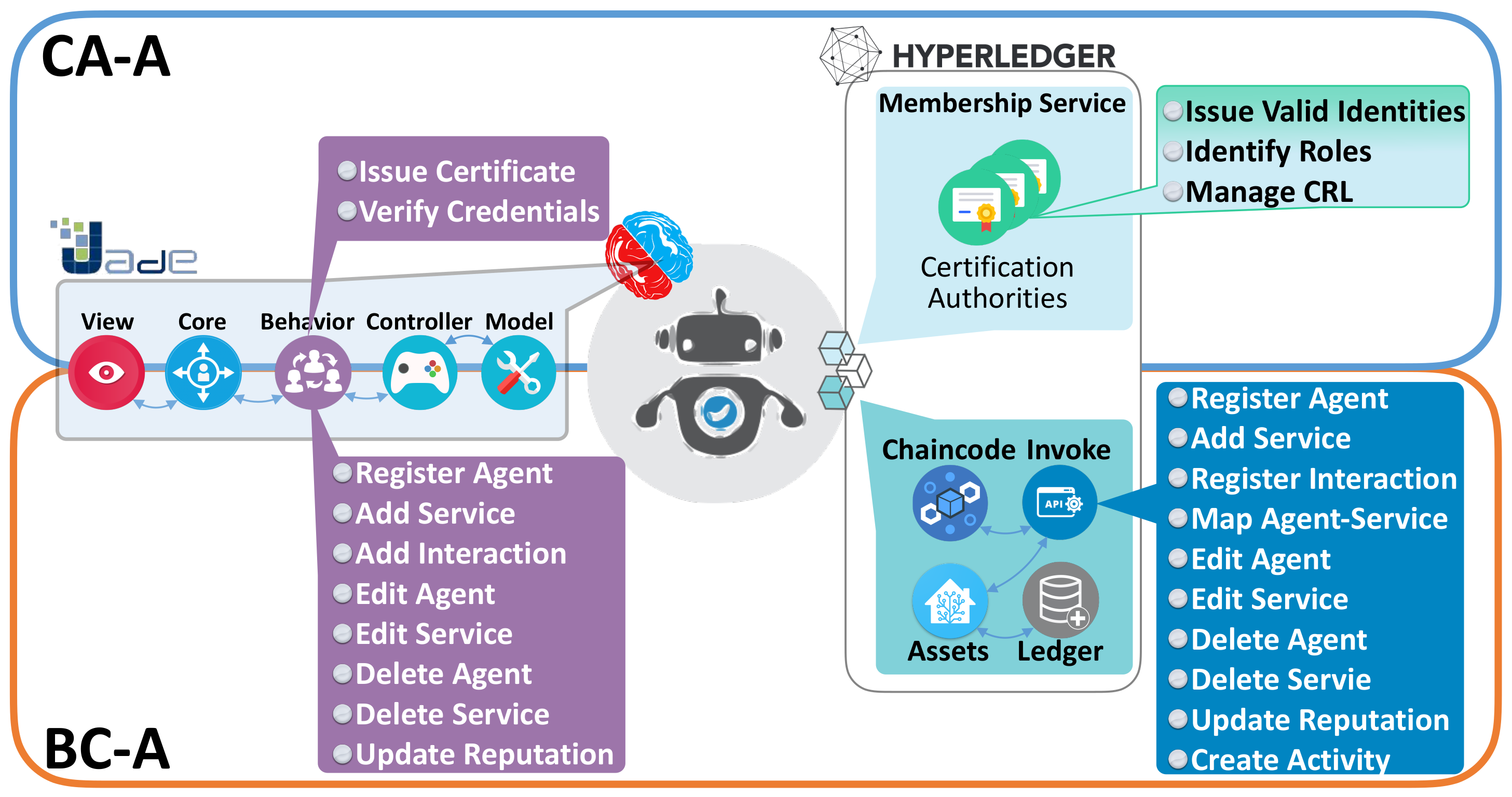
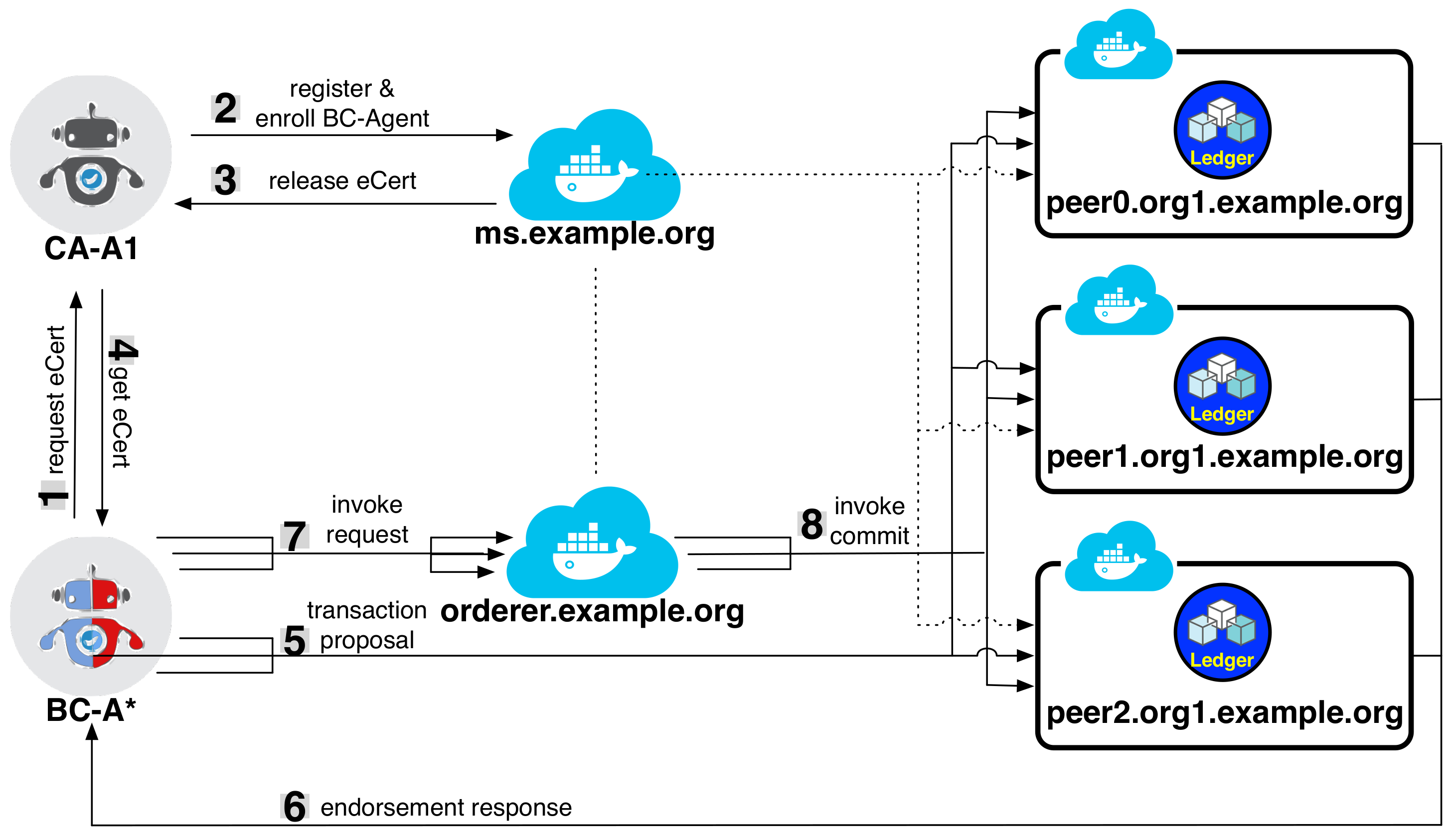

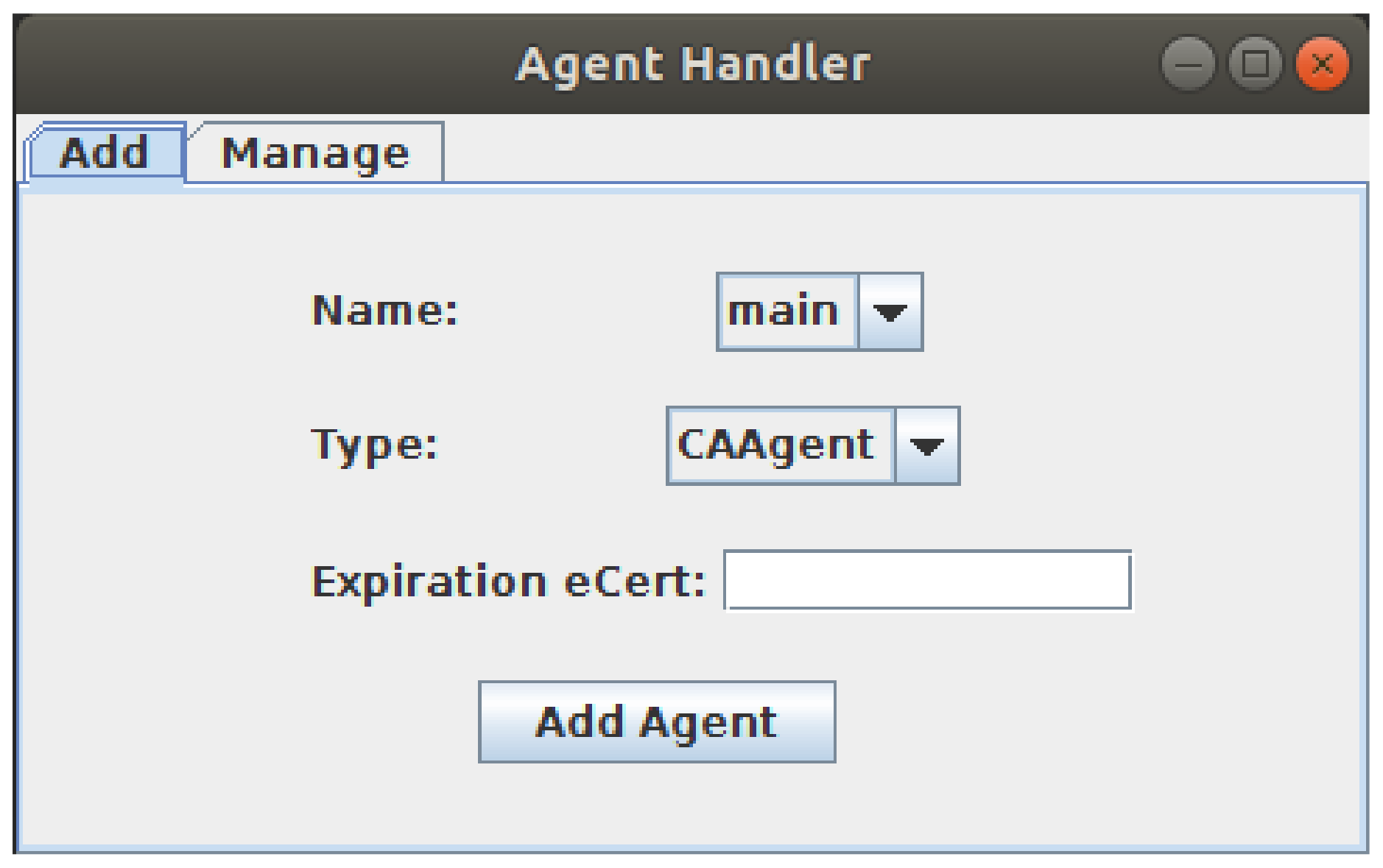
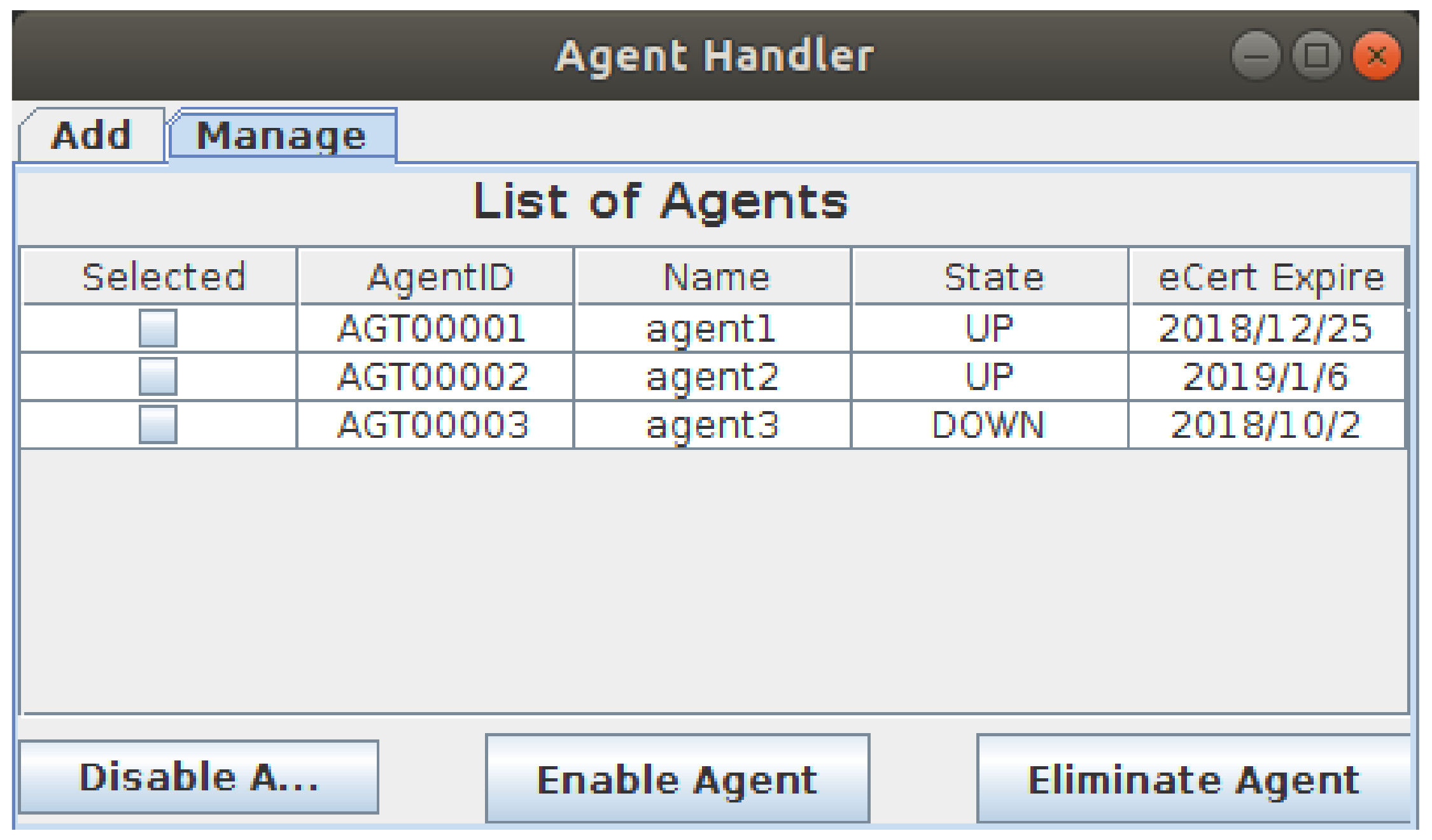
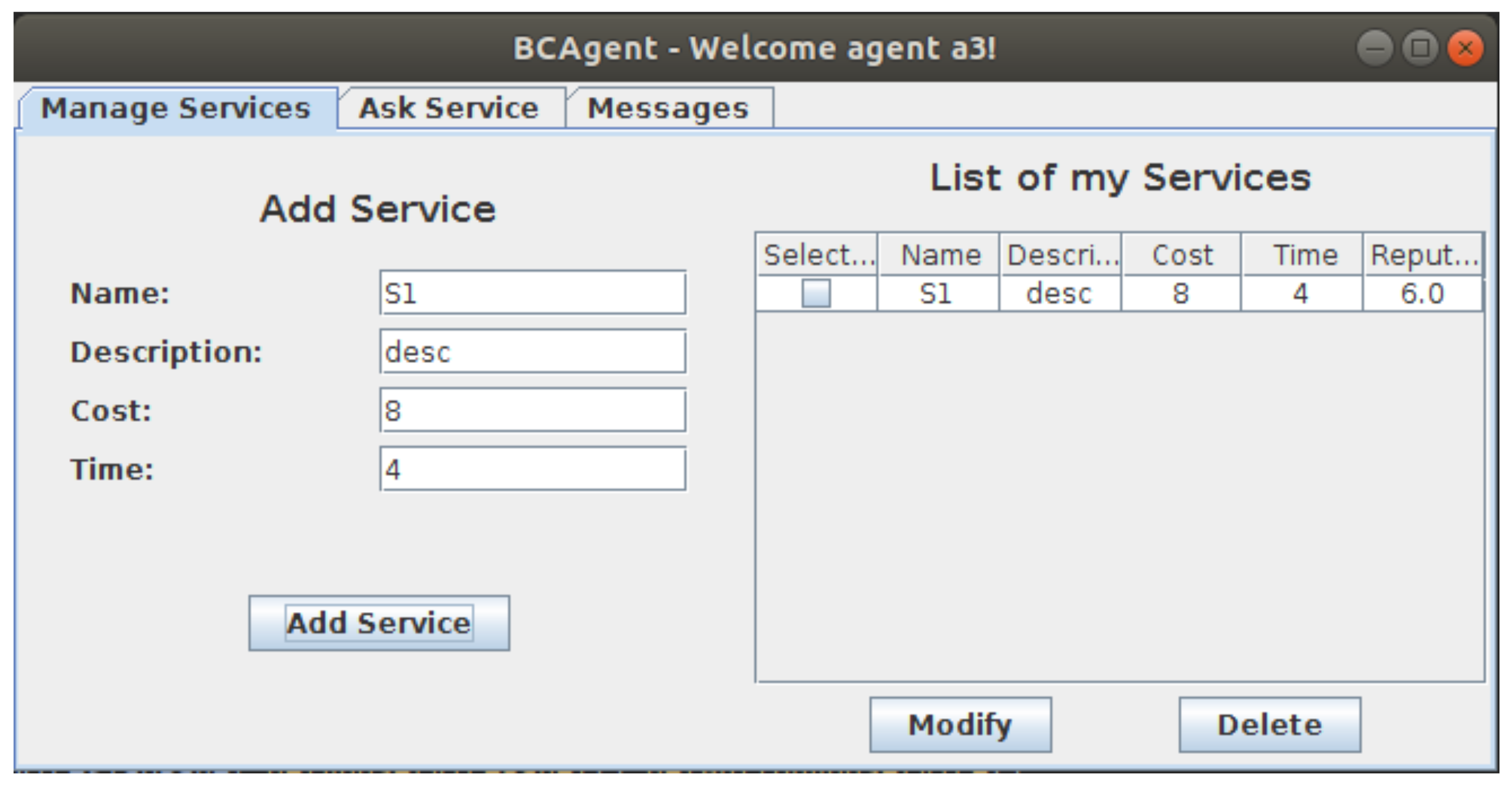
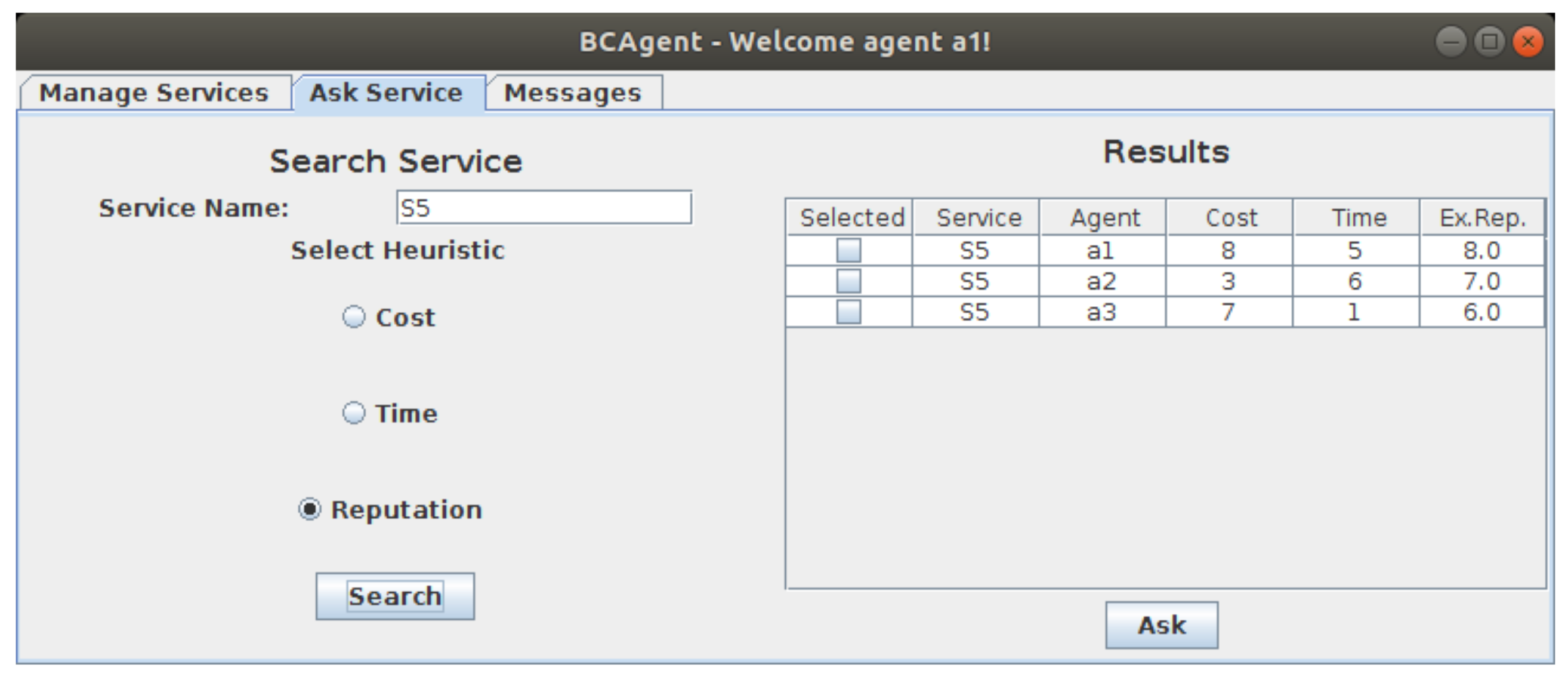
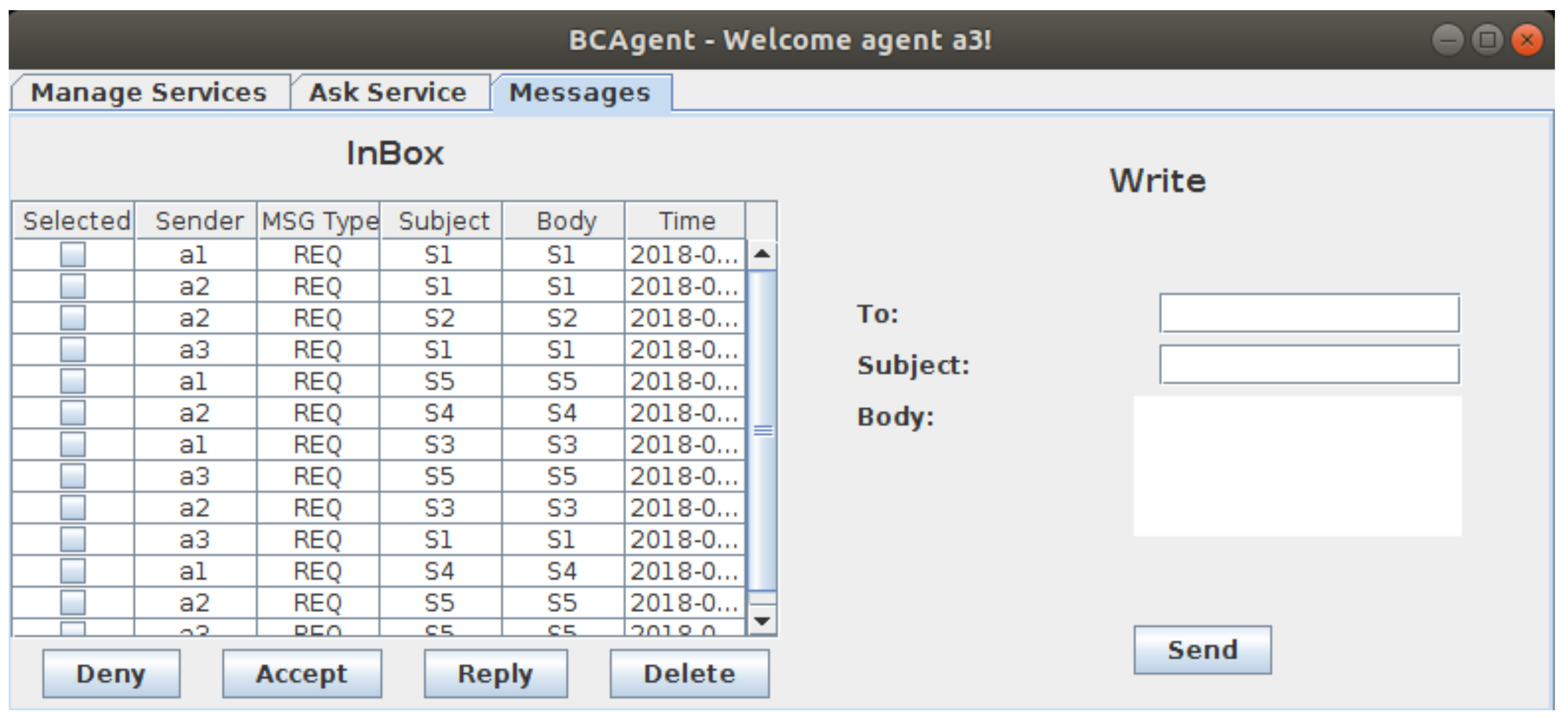
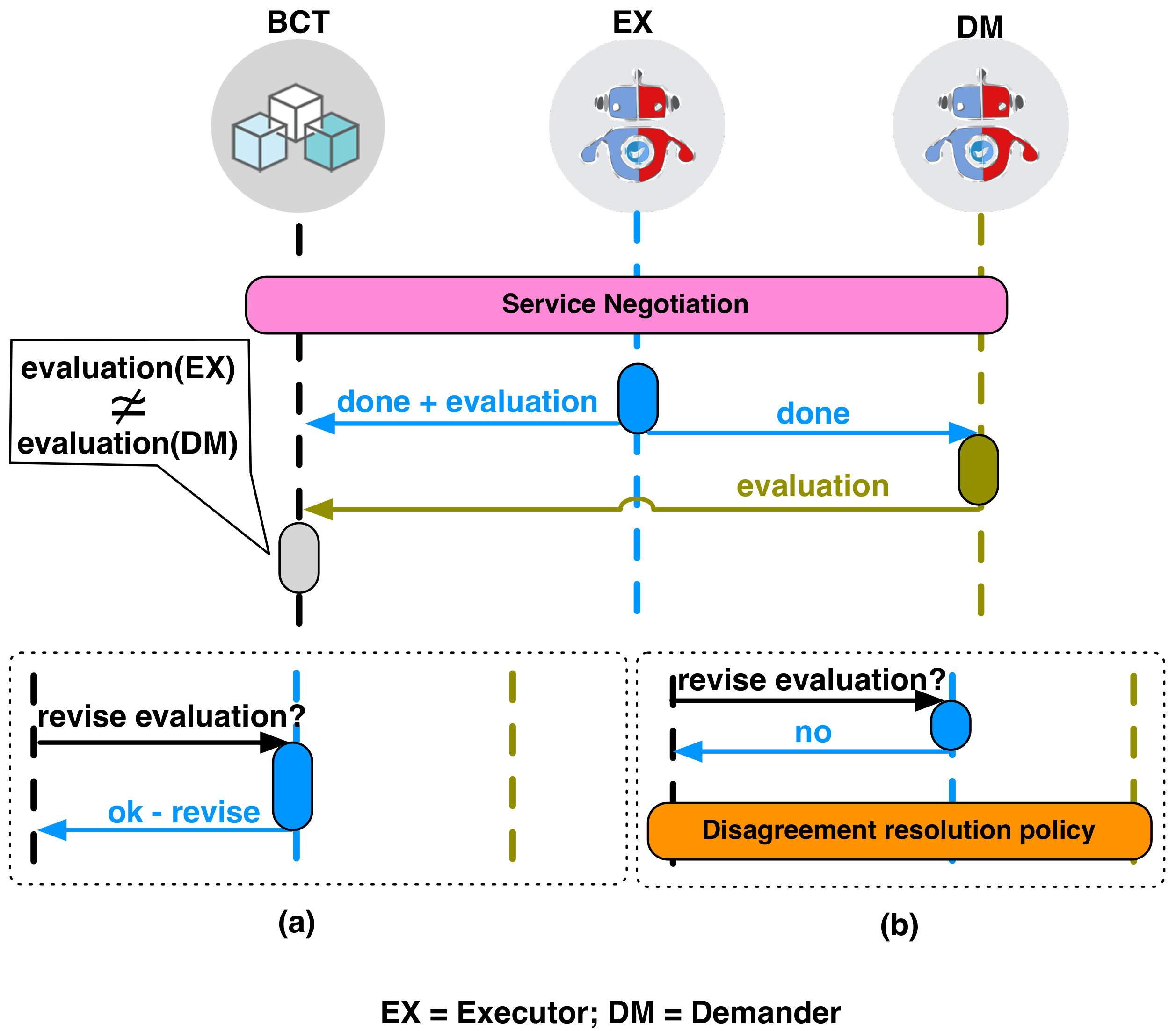
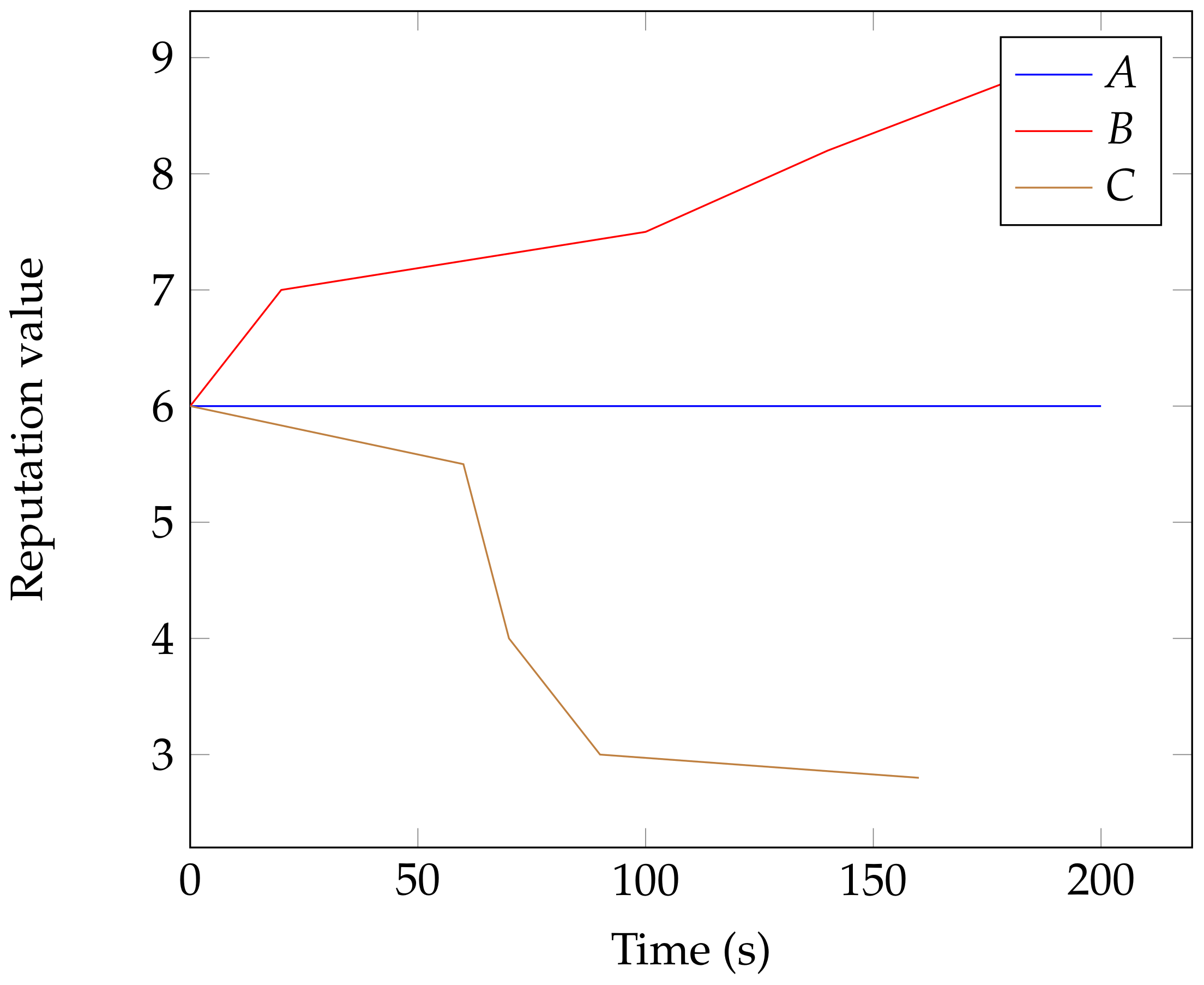
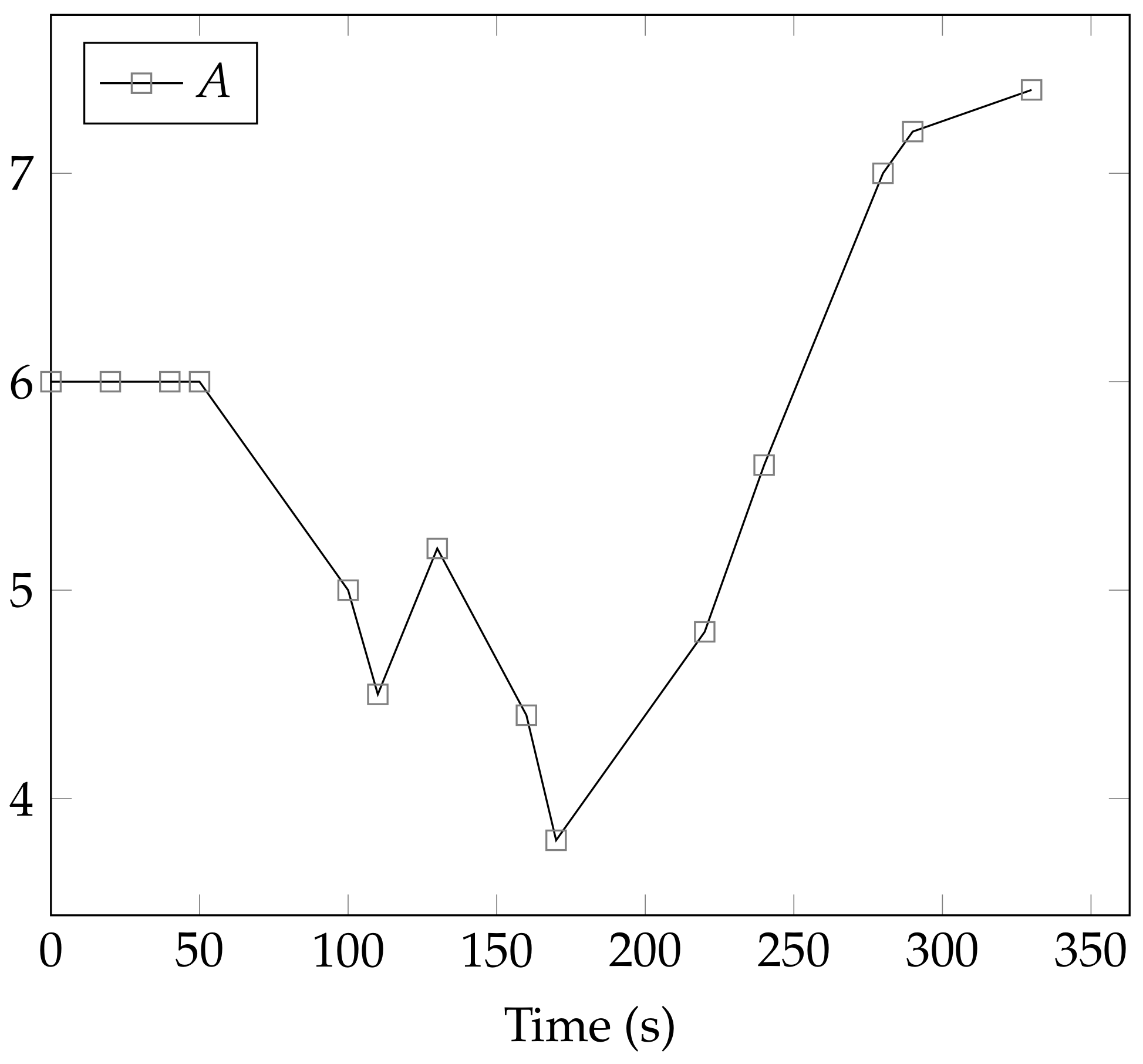
| Figure 10A | Figure 10B | Figure 10C | Figure 11A | |
|---|---|---|---|---|
| Exe | Stable | Bad evaluators(s), Performance in decline | Good Executor | Unpredictable, Time limited problem |
| Dem | Stable | Bad executor(s) Possible malicious intentions | Good evaluator | Honest mistake, Single bad action |
© 2019 by the authors. Licensee MDPI, Basel, Switzerland. This article is an open access article distributed under the terms and conditions of the Creative Commons Attribution (CC BY) license (http://creativecommons.org/licenses/by/4.0/).
Share and Cite
Calvaresi, D.; Calbimonte, J.-P.; Dubovitskaya, A.; Mattioli, V.; Piguet, J.-G.; Schumacher, M. The Good, the Bad, and the Ethical Implications of Bridging Blockchain and Multi-Agent Systems. Information 2019, 10, 363. https://doi.org/10.3390/info10120363
Calvaresi D, Calbimonte J-P, Dubovitskaya A, Mattioli V, Piguet J-G, Schumacher M. The Good, the Bad, and the Ethical Implications of Bridging Blockchain and Multi-Agent Systems. Information. 2019; 10(12):363. https://doi.org/10.3390/info10120363
Chicago/Turabian StyleCalvaresi, Davide, Jean-Paul Calbimonte, Alevtina Dubovitskaya, Valerio Mattioli, Jean-Gabriel Piguet, and Michael Schumacher. 2019. "The Good, the Bad, and the Ethical Implications of Bridging Blockchain and Multi-Agent Systems" Information 10, no. 12: 363. https://doi.org/10.3390/info10120363
APA StyleCalvaresi, D., Calbimonte, J.-P., Dubovitskaya, A., Mattioli, V., Piguet, J.-G., & Schumacher, M. (2019). The Good, the Bad, and the Ethical Implications of Bridging Blockchain and Multi-Agent Systems. Information, 10(12), 363. https://doi.org/10.3390/info10120363







